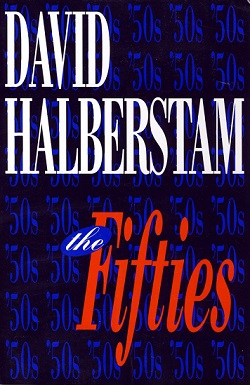

The Pulitzer-prize winning author David Halberstam’s study of the 1950s remains, after three readings, one of the most enjoyable works of history I ever picked up by accident. I was in a small bookstore on Yonge Street in Toronto and needed two more books to round out the $25 I was spending. The other one has long since been relegated to a shelf somewhere, but I keep picking this one up every year or two to go through it again.
Halberstam’s central thesis is that while the sixties was a seminal decade in American life – Vietnam, the counterculture, birth control, rock and roll, peace, love and what have you, all rocked the nation – the germination for many of the events that defined that decade actually originated before that, in the immediate post-war years. More, many smaller, less visible, but not less impactful occurrences also happened during the fifties which arguably had more far-reaching effects: Levittowns, the Cold War, discount stores, the beginning of the black migration from the south to the northern industrial centres, the origins of the Beat generation, the changes in cinema, decline in radio, advertising, research on contraception, fast food (the chapter on MacDonalds’s is brilliant)…I can go on and on.
Halberstam’s masterstroke is to make his chapters short and tightly focussed instead of droning on for hundreds of pages on grand themes that would inevitably try the patience of a scholar. Starting with the late 1940s, he sketches the main events from a political perspective. Truman, MacArthur, the origins of the Cold War, atomic reasearch, the return of GIs from service, the nascent middle class, are all touched on briefly. After that he ranges more widely, and not always chronologically, because his chapters tend to focus on one thing at a time. In a book this large – okay, okay, it’s 800 pages long — I’m amazed that it contains as much as it does in 46 succint chapters. And if the book has a weakness, it’s that the chapters are not labelled, only numbered, so one is not sure what one is getting into until halfway through a section (this is why my edition has my chapter titles inked in – “Rosa Parks and the advent of Civil Rights”, or “the 1952 Presidentials” and “The emerging impact of TV”…and we won’t even discuss the highlighting that is on almost every page).
David Halberstam was a journalist and author who cut his teeth reporting on the Viet Nam war, and wrote a seminal work on US hubris leading to that debacle and the subsequent influence of those policies and decisions called “The Best and the Brightest,” which I also recommend highly. He first came to my attention when I read his book “War in a Time of Peace” which discussed the low intensity conflicts that raged following the end of the cold war and how the US dealt with them…in particular, Haiti, the Balkans and Somalia. He was a Pulitzer prize winner and loved baseball and sports, about which he also wrote several highly regarded books.
This glowingly positive review is probably not going to change anyone’s mind. If you’re not into history or current affairs, well, then I doubt I can convince you to pick up a tome this large in between all your other concerns. I myself usually take about a month to go through it. But if you are at all interested in the history of the 20th century and the forces that shaped American society and culture – and by diffusion, that of much of the western world – then this book is well written, informative and one of the best of its kind.